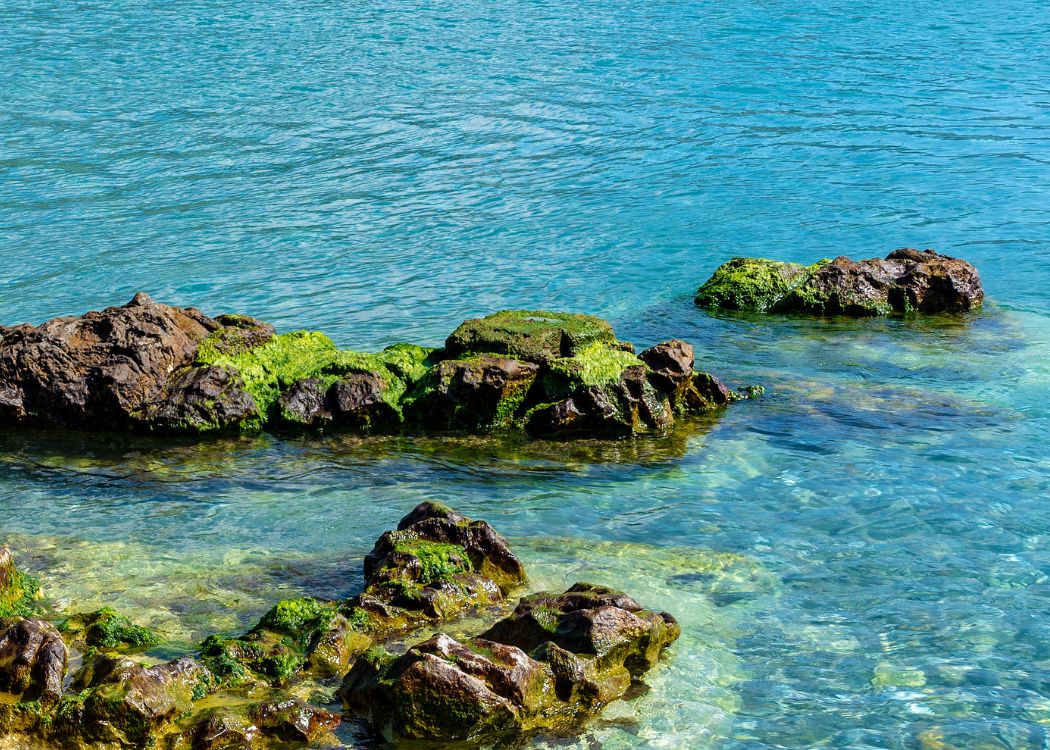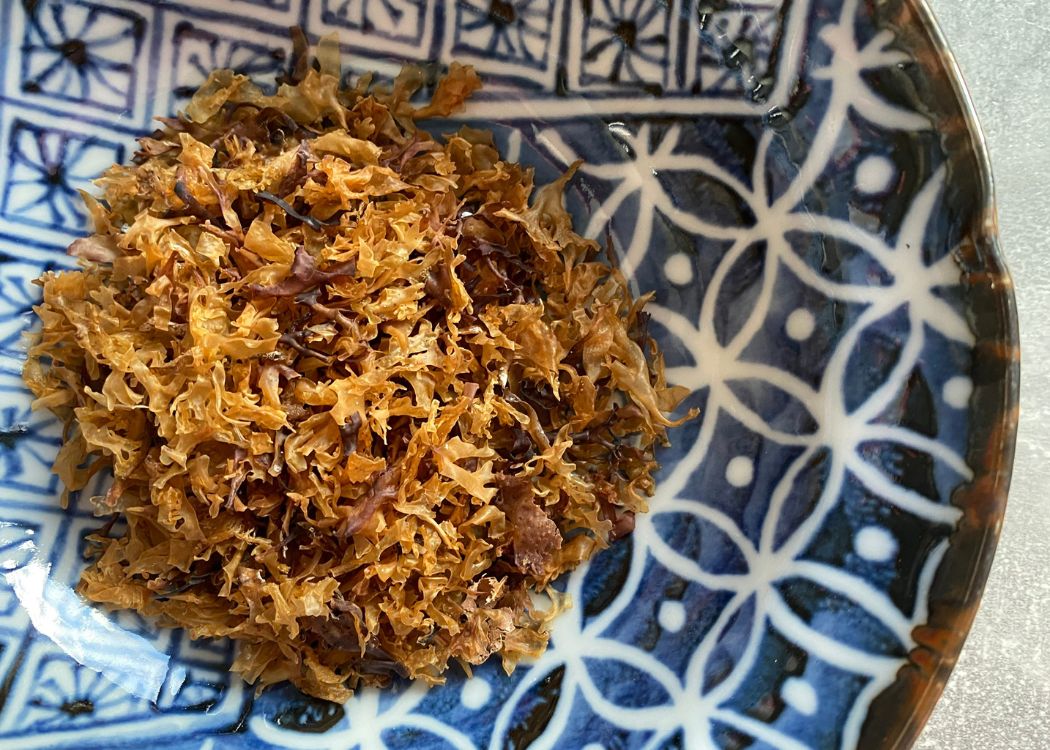Sea Moss Health Benefits, Different Forms, and Who Should Avoid It
Think sea moss, seaweed or algae and stepping on slippery rocks when you’re at the seaside may be a thought that comes to mind. But many sea moss are edible – they’re the highly nutritious vegetables of the sea. If you’re curious about what sea moss is and how to enjoy sea moss benefits without any side effects, here’s a summary of what you should know.
By Nina Sabat (BSc Dip NT)
- Sea moss is an umbrella term which relates to several genera of red algae. There are many more than 3, but when shopping for ‘sea moss’ you are most likely to be buying a species of Gracilaria or Gigartina or the species Chondrus crispus (aka Irish moss).
- You can buy Sea Moss as a raw, dried product, or as gel, in capsules, as a seasoning or tea.
- Sea moss red algae are a source of iodine, magnesium, vitamin C, amino acids, essential omegas, fibre, sulphated polysaccharides and other phytonutrients. Vegans and vegetarians often use sea moss to improve the nutritional value of a meal.
- In recent years, researchers have focused on potential sea moss benefits – especially for thyroid function, energy, digestion, weight management, and skin health. Studies suggest a positive influence, however there is space for more human research.
- Eating excessive amounts of sea moss may have unwanted side effects, such as iodine or heavy metal toxicity or digestive discomfort. You should avoid sea moss if you have a thyroid disorder, have a high heavy-metal load, are pregnant, on blood thinners or have a shellfish allergy.

What Is Sea Moss?
Algae are a type of seaweed, vegetables found growing in the sea along rocky shores or in fresh water. Typically, they are grouped according to their most visible pigment, which means algae fall into one of three colour divisions – red (Rhodophyta), brown (Phaeophyta) and green (Chlorophyta).
“Sea moss” is a catch-all term for several genera of red algae.
If you’re already a fan of seaweed, many red algae will be familiar to you – like dulse (genus Palmaria), nori and laverbread (both from the genus Porphyra) and carrageen moss (genus Mastocarpus).
However, if you’re shopping for sea moss you won’t get these. Today, the most popular sea moss on the market includes Gracilaria, Gigartina and Chondrus crispus (aka Irish moss).
Gracilaria (‘Bird’s Nest’)
There are over 160 species of Gracilaria red algae. What they look like depends on the strain and the conditions where they’re grown, but often Gracilaria are quite bushy and spaghetti-like – hence the nickname “Bird’s nest”. For red algae, Gracilaria come in a surprising array of colours – the algae blades can be black, brown or green, as well as red.
Gracilaria grow world-wide. Known as ogo or ogonori in Hawaii and Japan, this common seaweed is often harvested for its agar. The polysaccharide agar is found in Gracilaria cell walls. Agar forms a gel-like substance and is often used in the food industry to thicken yogurts, puddings and soups.
Gigartina
The Gigartina genus is also a big group, having over 400 different species, however Gigartina skottsbergi is most often used in manufacturing processes. Growing in the warm waters of the South Pacific, G. skottsbergi is harvested for its carrageenan, a thickening agent used in the food and cosmetics industry.
G. skottsbergi red algae is also frequently used by supplement companies.
Chondrus crispus (‘Irish Sea Moss’)
Chondrus crispus, is the Latin name for Irish sea moss, a red algae which grows in colder regions such as Europe, North America, Canada and Paris. Irish sea moss is readily available and very popular in the UK and Ireland.
Irish moss has flat, fan like leaves with frilled edges and can be dark purple in colour. This is because it’s particularly rich in anthocyanins – the same pigment which gives blueberries, aubergines and purple cabbage their rich colour.
As with G. skottsbergi, C. crispus is a source of the polysaccharide carrageenan.

Sea Moss Nutrition
Sea moss is valued as a nutrient dense food.
Bear in mind that as a wild, raw product the nutrient content can vary significantly from one sea moss to the next. This is because the nutrient profile of red algae is influenced by the species, the season, and the location where it grows.
The nutritional profile of red algae typically includes:
- Vitamins – particularly B vitamins and vitamin C
- Minerals – especially iodine, magnesium, manganese, potassium, sodium and zinc
- Fibre
- Fatty acids – notably palmitic, DHA, EPA, arachidonic, and oleic acids
- Amino acids – compared to brown and green, red algae may have more glutamate, ornithine, citrulline, serine and glycine. Tryptophan may be low
- Other phytonutrients – polyphenols, polysaccharides and glycoproteins
7 Potential Benefits of Sea Moss Taken Regularly
While animal models abound, research involving humans is slowly growing. Nevertheless, when taken regularly, there are various ways in which sea moss has the potential to benefit health.
1. Increased IMMUNITY
The anti-viral effect of polysaccharides has been well reported, and studies have confirmed that red algae have the same anti-viral properties too. This activity is attributed to their galactans, a class of sulphated polysaccharide, of which carrageenan is one type. [1]
How potent is sea moss for supporting your immune health?
Researchers in the PREVENT study were moved to describe GRFT, a protein from the red algae Griffithsia, as “one of the most powerful, broad‐spectrum antivirals ever tested”. [2]

2. Support for CHRONIC IMFLAMMATORY CONDITIONS
A different compound of red algae, homotaurine, has potential health benefits as it can activate GABA receptors in the brain. In mouse models, homotaurine regulates Th17 and Th1-mediated inflammation in the central nervous system.[3]
A future application for homotaurine extracts from sea moss may be in disorders where a T-cell mediated autoimmune response attacks healthy human tissue. This includes multiple sclerosis, rheumatoid arthritis and type 1 diabetes.
3. Healthy WEIGHT LOSS
Seaweed has anti-obesity effects. It is also being considered for its effect on metabolic syndrome - where diabetes, high blood pressure, raised blood lipids and obesity are clustered together. The incidence of metabolic syndrome is increasing worldwide, but notably not in countries where seaweed is regularly eaten.
Should we be eating red algae to lower the risk of metabolic syndrome and obesity?
Studies record reductions in blood pressure, weight and waist circumference [4] and healthier blood fats, [5] suggesting eating sea moss regularly may help improve your metabolic health and support your weight loss goals.
Explore Revital's weight loss range.
4. Relief from CONSTIPATION
Red algae contain a lot of non-digestible fibre, prompting researchers to question if sea moss can help people who find it hard to poo.
In one of the first studies on humans, researchers investigated Gelidium elegans, a red alga that commonly grows in Asia. [6] After the 12-week study, the algae-eaters reported less abdominal discomfort and fewer symptoms of constipation.
5. Natural OMEGA-3
Omega-3 oils are well-known for supporting heart health, as well as your joints, eyes, brain and mood. Not eating fish – perhaps due to dietary choices or allergy – can leave your diet lacking in essential omega-3 EPA and DHA.
In one study, supplementing algae oil effectively raised the blood omega-3 levels in vegetarians with a low omega-3 status. [7] A benefit of eating sea moss is that it contains natural oils which are rich in omega-3 DHA.
6. Healthier SKIN
Red algae is used in many skin care products and has a huge range of beneficial effects. Algae carbohydrates are amongst the actives [8] but there are other compounds in sea moss which bring benefits to your skin.
Sea moss acts:
- as an antioxidant and skin brightener – it’s rich in vitamin C, anthocyanins and beta carotene
- as a UV protector – due to its mycosperine-like amino acids
- to hydrate and plump the skin – the hydrated fibrous gel acts as a humectant attracting water to the surface of the skin
7. Healthy THYROID hormones
Healthy thyroid activity has a huge impact on wellbeing. Your heart rate, body temperature, calorie use and energy expenditure are all regulated by thyroid hormone, thyroxine (T4) and triiodothyronine (T3). Mood, motivation and skin health are also affected by the amount of thyroid hormone you make.
Iodine is an essential building block for thyroid hormone and a low intake can contribute to not having enough hormone for optimal health. In fact, iodine deficiency is the most common cause of an underactive thyroid, hypothyroidism.
Foods which are rich in iodine include fish, eggs, beef liver and chicken.
If you are vegan, vegetarian, or don’t like eating these foods, sea moss is a superior choice. In one study sea moss was particularly beneficial for women whose low iodine levels were reversed when they took a seaweed supplement 3 times a week. [9]
What Are Some Sea Moss Side Effects I Need To Watch Out For?
Generally, you should avoid sea moss if you have a high heavy-metal load, are pregnant, on blood thinners or have a shellfish allergy.
Other sea moss side effects to watch out for include:
- Digestive discomfort – with its high fibre content sea moss will naturally absorb water as it passes through your digestive tract. If you are dehydrated or typically drink little fluid this could leave you feeling bloated or constipated.
- Palpitations, sweating, dizziness – frequently consuming large quantities of sea moss could put you at risk of an iodine and tyrosine overload. This may potentially impact your thyroid hormone levels causing you to be metabolically ‘revved up’.
How To Take Sea Moss in All Its Forms
There are very few barriers to taking sea moss. Gone are the days of needing to scavenge your algae from a rocky, coastal shore!
Raw Dried Sea Moss
If you’re planning to take sea moss which is raw and dried, the first step is to rehydrate it and make a sea moss gel. Sea moss will swell to around 3 times its size, so a little will go a long way.
- The recommended serving size of sea moss gel is 1 – 2 tablespoons
- The gel from dried sea moss is a great choice if you are looking to give a boost to your general nutrition or increase your intake of fibre
- A second advantage of using sea moss gel is that it is suitable for children and adults who struggle to swallow pills
- Thirdly it is versatile. How about making a face mask enriched with sea moss gel?

Sea Moss Capsules
Sea moss capsules contain washed, ground, dried algae, that hasn’t gone through the rehydration process.
- Check the product label for the recommended serving size of your sea moss capsules.
- Sea moss capsules are a great choice if you are looking to give a boost to your general nutrition or increase your intake of fibre
- Advantages to using sea moss capsules are that no preparation is necessary, and the capsules are tasteless
- In addition, sea moss capsules have a much longer shelf life than sea moss gel, which should be refrigerated and consumed within 3 weeks
How Can I Get More Sea Moss into My Diet?
With so many potential healthy sea moss benefits, red algae really should be a kitchen-cupboard essential.
To get more sea moss in your diet, make up a batch of sea moss gel and use it to thicken stews or set a mousse or pudding. Or keep it simple and add a tablespoon of sea moss gel to a smoothie enriched with maca, cacao, acai, MCT oil or any other super-healthful food.

How to prepare sea moss gel
- To make a batch of sea moss gel take 25g of the dried algae, and rehydrate it by soaking in warm water for around 20 minutes
- After that rinse it well to remove any sand or grit, then simmer in fresh water for 15 – 20 minutes
- Blend the sea moss and water into a gel
- Store in the fridge (for up to 3 weeks) and use as desired
Ready to boost your nutrition and enjoy the benefits of red algae?
Buy your Indigo Herbs Irish Sea Moss here
References
[1] Sansone et al, 2020. Marine algal antioxidants as potential vectors for controlling viral diseases
[2] Cochrane register of controlled trials, 2019 Griffithsin-based Rectal Microbicide for PREvention of Viral ENTry (PREVENT)
[3] Tian et al, 2018. Homotaurine, a safe blood-brain barrier permeable GABAA-R-specific agonist, ameliorates disease in mouse models of multiple sclerosis
[4] Baldeon et al, 2010. Could dietary seaweed reverse the metabolic syndrome?
[5] Nakamura et al, 2020. Effects of Palmaria palmata on lipid metabolism and glycemic control in participants with hypercholesterolemia in a randomized double-blind placebo-controlled trial
[6] Choi et al, 2019. Efficacy and safety of Gelidium elegans intake on bowel symptoms in obese adults
[7] Kraft et al, 2015. Docosahexaenoic acid supplementation in vegetarians effectively increases omega-3 index: a randomized trial
[8] Kim et al, 2018. Beneficial effects of marine algae-derived carbohydrates for skin health
[9] Nicol et al, 2021. Using seaweed as a supplement or a food ingredient to increase
About Nina Sabat (BSc Dip NT)
Nina leads Revital’s online customer consultation service and is a Registered Nutritional Therapist. In practice, Nina takes a ‘habits first – food second – supplements third’ approach to better health. In life, Nina feels there’s no challenge too big to face – especially after a proper night’s sleep, a deep breath or two, and perhaps a slice of homemade chocolate...